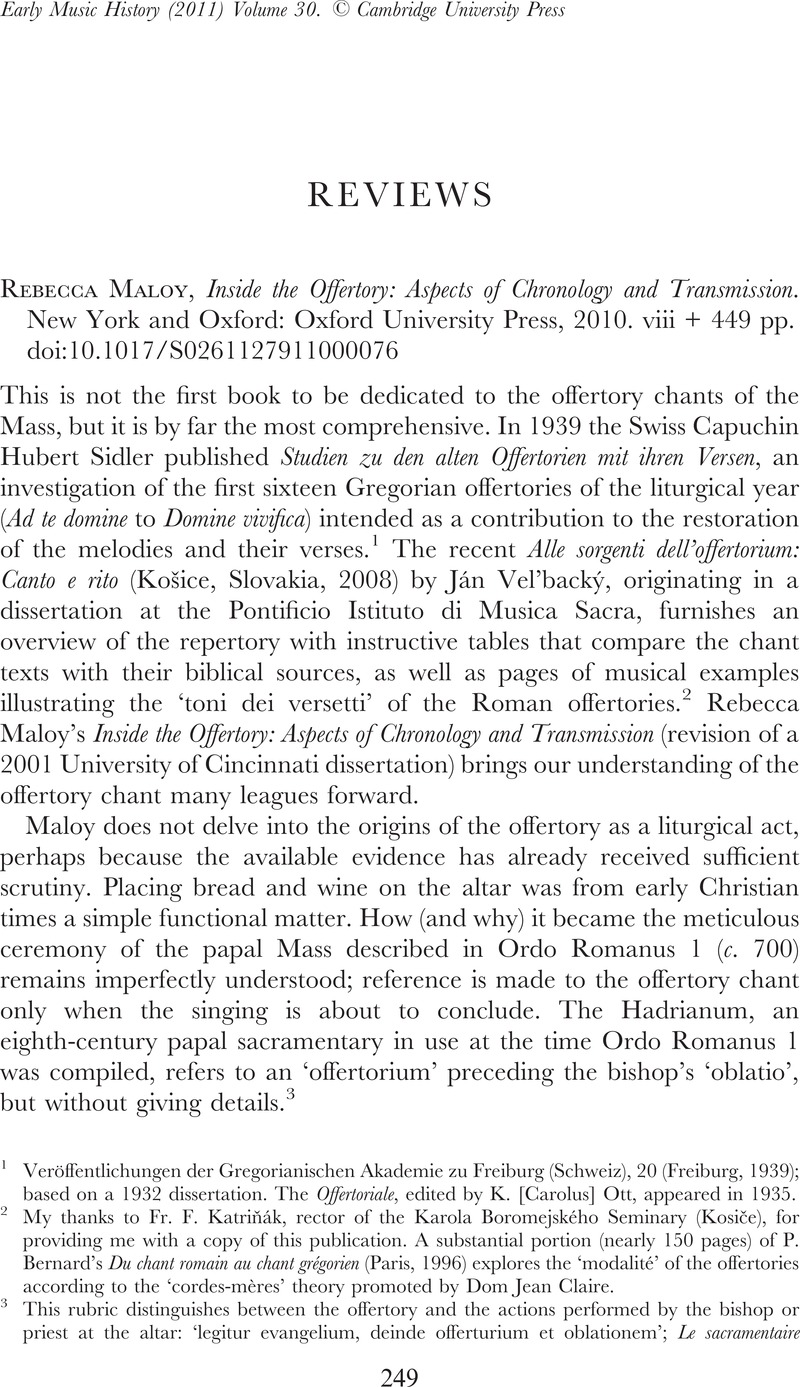No CrossRef data available.
Published online by Cambridge University Press: 08 September 2011

1 Veröffentlichungen der Gregorianischen Akademie zu Freiburg (Schweiz), 20 (Freiburg, 1939); based on a 1932 dissertation. The Offertoriale, edited by K. [Carolus] Ott, appeared in 1935.
2 My thanks to Fr. F. Katriňák, rector of the Karola Boromejského Seminary (Kosiče), for providing me with a copy of this publication. A substantial portion (nearly 150 pages) of Bernard's, P.Du chant romain au chant grégorien (Paris, 1996)Google Scholar explores the ‘modalité’ of the offertories according to the ‘cordes-mères’ theory promoted by Dom Jean Claire.
3 This rubric distinguishes between the offertory and the actions performed by the bishop or priest at the altar: ‘legitur evangelium, deinde offerturium et oblationem’; Le sacramentaire grégorien: Ses principales formes d'après les plus anciens manuscrits, ed. J. Deshusses, 3 vols (Spicilegium Friburgense, 16, 24, 28; Freiburg, 1971–92), i, p. 86. The earliest manuscript of the Hadrianum modifies this: ‘legitur evangelium, deinde offertorium et oblationem super oblata’.
4 A surprising number of offertories with verses have been recorded; see Weber, J. F., ‘Offertories with Verses on Sound Recordings’, in The Offertory and its Verses: Research, Past, Present and Future. Proceedings of an International Symposion at the Centre for Medieval Studies, Trondheim, 25 and 26 September 2004, ed. Hankeln, R. (Trondheim, 2007), pp. 123–151Google Scholar .
5 <www.oxford.com/us/insidetheoffertory>. User name: ‘Music4’ and password: ‘Book2497’.
6 Oddly, the chant texts are compared with the Vulgate in Rumphorst, H., ‘Gesangtext und Textquelle im Gregorianischen Choral’, Beiträge zur Gregorianik, 13–14 (1992), pp. 181–209 and 23 (1997), pp. 29–51Google Scholar .
7 Only three offertories of the core repertory are based on New Testament texts: Beatus es Simon, Angelus domini and Ave Maria.
8 The text of the Roman Psalter (or appropriate biblical source) is compared to the offertories of the Old Roman gradual (BAV, Vat. lat. 5319) in Alle sorgenti, pp. 63–159. Verses omitted from the offertories are included in the psalter column.
9 This is no longer considered to be Jerome's (now lost) first revision of the Psalter (c. 383).
10 Petitmengin, P., ‘Les plus anciens manuscrits de la Bible latine’, in Fontaine, J. and Pietri, C. (eds.), Le monde latin antique et la Bible (Paris, 1985), pp. 89–123Google Scholar . Only thirty-one surviving psalters can be dated before 800; see McGurk, P., ‘The Oldest Manuscripts of the Latin Bible’, in Gameson, R. (ed.), The Early Medieval Bible: Its Production, Decoration and Use (Cambridge, 1994), pp. 1–23, esp. pp. 3–4Google Scholar .
11 ‘Le psautier latin des origines au xiie siècle: Essai d’histoire', in Aejmelaeus, A. and Quast, U. (eds.), Der Septuaginta-Psalter und seine Tochterübersetzungen: Symposium in Göttingen 1997 (Göttingen, 2000), pp. 51–81Google Scholar , at p. 62.
12 (Collectanea Biblica Latina, 4; Rome, 1913).
13 Le texte du psautier latin, 86; see also pp. 117–19 (‘[α] est purement et simplement un texte africain’), pp. 187–91.
14 Dold, A. and Allgeier, A., Der Palimpsestpsalter im Codex Sangallensis 912: Eine altlateinische Übersetzung des frühen 6. Jahrhunderts aus der einstigen Kloster-Bibliothek von Bobbio (Texte und Arbeiten, 1/21–4; Beuron, 1933), pp. 30–52Google Scholar .
15 Ibid., pp. 66–84.
16 Vaccari, A., ‘I salteri di s. Girolamo e di s. Agostino’, and ‘Saint Augustin, saint Ambroise et Aquila’, in Scritti di erudizione e di filologia, 2 vols. (Rome, 1958), i, pp. 207–255Google Scholar ; ii, pp. 229–43.
17 ‘Saint Augustin’, p. 239.
18 Bogaert, ‘Le psautier latin des origines’, pp. 62 and 70 (‘le texte du psautier habituellement cité par Augustin, proche du Veronensis [α], était bien originaire du Nord de l’Italie').
19 These correspondences can be seen in Maloy's appendix 1.
20 Inside the Offertory, p. 32, where a question is raised about the sufficiency of surviving psalter evidence. The caption and column headings (Alpha, Gaulois, Mixture) of Table 2.1, ‘Offertories with Textual Traditions Other than the PsR’, may give the impression that the evidence is stronger than it is.
21 Due to space considerations only a few examples are given; access to the website allows readers to follow the discussion. Some examples may be studied in my Early Music History article of 1998 (vol. 17) and Alle sorgenti, pp. 195–215 (‘tono di do’) and 217–32 (‘tono di mi’).
22 A related theme is taken up later in the chapter (‘Rhetorical Treatment of the Words’).
23 Published too late for consideration is Bailey, T., The Chants of the Ambrosian Offertory: The Antiphons ‘After the Gospel’ and the Offerendae (Musicological Studies, 92; Ottawa, 2009)Google Scholar .
24 The chants of the Milanese Commune dominicarum and Commune sanctorum are almost totally dependent on the Gregorian repertory.
25 If such is the case, Gregorian chant should probably be called ‘Roman’ and the local Roman repertory might better be characterised as ‘late’ or ‘new’ Roman chant.
26 The turbulent history of Rome in the early Middle Ages was not conducive to stability of any kind.
27 Frankish cantors were instructed to learn Roman chant exactly: ‘ut pleniter discant’, according to one of the Carolingian capitularia.
28 For an example of this diversity see the tables in the appendix to my ‘Advent and the Antiphonale Missarum’, in Saulnier, D.et al. (eds.), Lingua mea calamus scribae: Mélanges offerts à madame Marie-Noël Colette (Études grégoriennes, 36; Solesmes, 2009), pp. 101–129Google Scholar .
29 This can be concluded from the studies of Bernard, P., ‘Le chants du Propre de la Messe dans les répertoires “grégorien” et “romain ancien”: Essai d’édition pratique des variantes textuelles', Ephemerides Liturgicae, 110 (1996), pp. 210–251Google Scholar , 445–50; the findings are interpreted in id., ‘Les variantes textuelles entre “vieux-romain” et “grégorien”: Quelques résultats’, in Saulnier, D. with Albert, M. (eds.), Requirentes Modos Musicos: Mélanges offerts à Dom Jean Claire (Solesmes, 1995), pp. 63–82Google Scholar .
30 Andrieu, M., Les Ordines Romani du haut moyen-âge, 5 vols (Spicilegium Sacrum Lovaniense, 11, 23–4, 28, 29; Louvain, 1931–61), iii, pp. 224–225Google Scholar (no. 39).
31 Emma Hornby has dedicated monographs to the second- and eighth-mode tracts, published in 2009 and 2002 respectively.